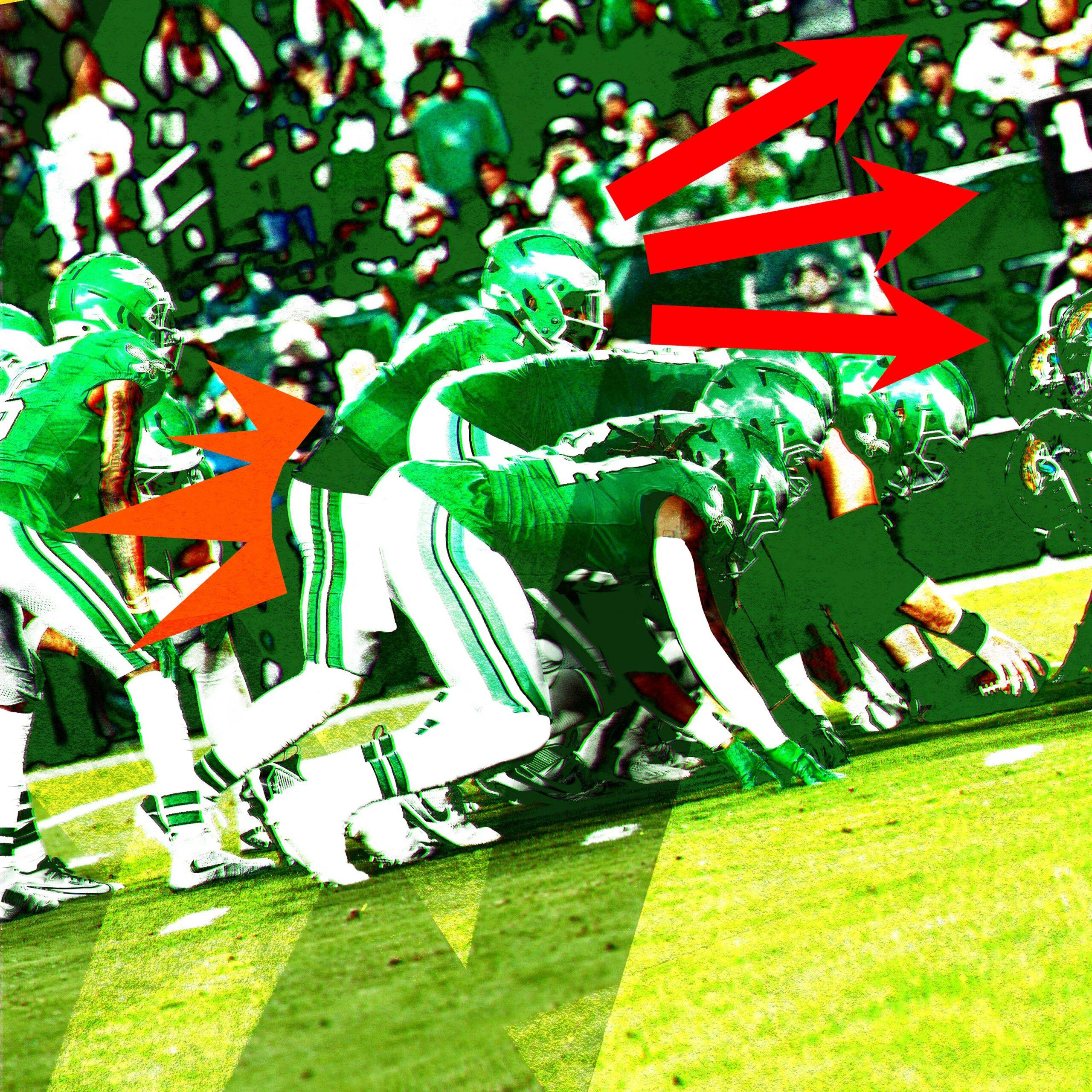
If you’ve spent any amount of time watching football, you know it’s a game of inches.
Perhaps no team knows this better than the Eagles, who, over the past three seasons, have essentially been able to run their signature play, the tush push, to gain one single yard whenever they need it. Philadelphia ran it five times in the NFC championship game against Washington, and picked up a first down or scored a touchdown on four of those attempts. That play isn’t the only reason the Eagles bested the Commanders—the final score was 55-23, after all—but it largely allowed Philadelphia’s offense to control the game and sap the life out of their divisional rivals.
Despite the Eagles’ success on sneaks over the past three years, only one other team has copied them by regularly sending its quarterback into the teeth of the defense: the Buffalo Bills. But Josh Allen was successful on just two of his six sneaks on their modified version of the tush push in the AFC championship game, including the crucial—and controversial—fourth-down failure that helped swing the game to the Chiefs.
In short, this Super Bowl matchup was decided by quarterback sneaks. And on Sunday, whether the Chiefs defense can once again stop the play could determine whether Kansas City three-peats or whether the Eagles avenge their Super Bowl loss from two years ago and claim the franchise’s second Lombardi Trophy.
The tush push is the most important play of Super Bowl LIX. Who has the edge when a single yard is on the line?
Shortly after Philadelphia unveiled the tush push in 2022, some fans called for the play to be banned. The Eagles were converting on the play at roughly a 90 percent clip. The thought was that once the tush push spread leaguewide, it would revolutionize football and sap all the tension out of short-yardage situations. But that didn’t happen. Most teams couldn’t find a way to consistently run the play effectively, and in 2024, only two quarterbacks were regularly thrown into the defense. This season, Jalen Hurts had 37 under-center rushing attempts on downs with just 1 yard to go. Allen recorded 26 such plays. In third place? Denver’s Bo Nix with just 13 attempts (bet you weren’t going to guess that one).
The Chiefs had all but abandoned the QB sneak after Patrick Mahomes injured his knee attempting one in 2019. He didn’t have a single under-center run snap with 0-2 yards to go this season. And the Ravens don’t run Lamar Jackson, the best rushing QB in league history, this way. Instead, they’ve used the tush push with tight end Mark Andrews.
When it comes to the QB sneak, the Eagles and Bills stand alone. But which team is better at it? Despite how much we associate the Eagles with the tush push, the data is very close. Here is how the two stacked up in 2024, including the postseason:
Short-Yardage QB Rushing, 2024
I was stunned to see Allen beat out Hurts here in first-down rate, even if it’s just by a small margin. But just look at the EPA numbers. Hurts gets the edge in EPA largely because so many of his sneaks came at the goal line, resulting in an incredible 13 touchdowns, but both QBs are incredibly effective. For context, Allen and Jackson tied for the league lead in EPA per play among quarterbacks this season at 0.18. So an Allen QB sneak is worth nearly double an average Allen play. Hurts put up 0.11 EPA per play, so he’s nearly six times more effective when being shoved forward. Of course, the Bills and Eagles have to be very close to a first down or a touchdown for the play to be effective—you can’t build the whole offense out of tush pushes—but this is probably the most valuable play in all of football.
Just look at how the QBs do compared to running backs. There is a reason the Eagles, even though they may have the best running back in football, still prefer giving the ball to their quarterback and using 1,646 pounds of offensive linemen to push him forward on short yardage. Here’s how the 10 best RBs (by total first downs gained) in 1-yard-to-go situations stack up in 2024:
Short-Yardage RB Rushing, 2024
No running back matches the success rate of Hurts or Allen. In fact, no running back with more than five short-yardage attempts cracked an 80 percent success rate on such plays this season. If you need a yard, there is no better player to send up the gut than Allen or Hurts.
So how did the Chiefs stop Allen and the Bills on these QB runs in the AFC title game? How did they take a play with north of an 80 percent success rate and reduce that to 33 percent when it mattered most? They simply knew what Allen and the Bills were going to do: run left.
On the Bills’ first use of the play in the AFC championship game, the offense got up to the line quickly, and before Kansas City’s defense was fully set, Allen dove behind left guard David Edwards to pick up 2 yards and a first down:
It seemed like Buffalo would have another routine day sneaking the football, just as the team did in their regular-season matchup with Kansas City, when the Bills went 2-for-2 on such plays. But on their next tush push—a third-and-goal from just beyond the Chiefs’ 1-yard line—the Chiefs started to get smart. By now, broadcasters Jim Nantz and Tony Romo had noted that Kansas City’s defense had practiced for Allen to mostly take these designed runs toward the left side of his offensive line, and here Allen actually skipped left before plowing forward. The Chiefs stopped him short of the goal line.
After scoring on the next play, Allen and the Bills went back to the tush push to try to notch a two-point conversion. Here, their play looked a bit more like the Eagles’ version, with all their players bunched together, but Allen and the offense couldn’t push through the Chiefs defense. Again, he went to the left on his sneak.
A few minutes later in the third quarter, Allen went toward the left side, again unsuccessfully:
Slow it down and you can see how the Chiefs defense looks prepared to collapse to the exact spot Allen is moving toward. They pretty much knew what was coming.
“I mean, from our defensive side, he always QB sneaks to our right,” Chiefs defensive back Nazeeh Johnson said last week. “So every time we see him in QB sneak formation, we know he’s coming to the right side every time. It’s 100 percent, 10 for 10, he’s going to that side.”
“If they would’ve, you know, I think self-scouted a little bit, then they would’ve went to the opposite side and they probably would’ve had a little more chance,” Johnson continued. “But, no, we sell the farm on what they like to do on film.”
The Bills followed up that unsuccessful sneak with an immediate second tush push on fourth-and-1, though here, they changed things up. They lined up with everyone near the ball, instead of leaving a few receivers out wide, and instead of going to the left, Allen went up and over his offensive line:
This technically went down as a success—Allen picked up the first. But he also fumbled the ball, creating a moment of panic before it was clear that he’d also recovered it. This is the type of play that only makes sense to run on the goal line, where the play would end the moment the ball crossed the plane.
And the Bills’ final attempt at a tush push a few minutes later is the one that swung the game. On fourth down, near midfield, Allen once again went behind the left side of his line.
Whether he actually picked up the first down or not will be something Bills fans can Zapruder film over for decades if they want to. He was ruled short after review, and the Chiefs scored a go-ahead touchdown just minutes later. That it was this close at all is already a failure for Buffalo: Look at where the ball is before the snap. The Bills needed to gain just a third of a yard. A successful tush push would have left no ambiguity.
This is where the Bills’ season ended. What about the Eagles? Just because Kansas City was able to stop Buffalo doesn’t mean it can stop Philly. That’s because the Eagles’ tush push looks nothing like the Bills’ version of the play—and crucially, the Eagles don’t care if the defense knows where they’re going with the football. Here’s an example from the second quarter of the NFC championship game:
The Eagles almost always keep their receivers bunched up at the line of scrimmage for this play. Unlike the Bills, they don’t keep the option of a pass open at all—it’s tush push all the way. You can see the difference in how the two teams get into the play: The Eagles took 37 of their 43 sneaks (86 percent) from 12 personnel—one running back, two tight ends—while the Bills did more work out of 11 personnel (54 percent). The Bills also like to go no-huddle before a sneak, doing so on 21 of 35 attempts (60 percent), while the Eagles did so on just nine of 43 attempts (21 percent).
Essentially, the Bills like to keep some facade that their QB sneaks might actually be something else. The Eagles don’t care if every single person in the stadium knows exactly what they’re going to do.
And while I’m not a scout, I’d say the Eagles offensive line gets lower than the Bills offensive line. Look at some of the Buffalo clips above, and the Bills offensive line looks like they could be ready for any old play. By comparison, almost any clip of the Eagles running the tush push looks more like a rugby scrum. Look at how low they get on this play against Baltimore in Week 13.
Then there is where the two quarterbacks actually push toward. Allen’s tendency to go to the left is what helped the Chiefs stop him. Hurts also sometimes drifts to the left, but not as frequently or as dramatically as Allen does. He’s almost always moving north-south.
If I had to sum it all up, I’d say Allen runs his sneaks with the intent of going through the defense. Hurts tries to go under the defense. The Eagles’ ability to get low and get leverage is simply unmatched.
Will the Chiefs find a tendency about the Eagles that they can exploit the way they did against the Bills? I’m not going to doubt Steve Spagnuolo, but I will note that, shockingly, Kansas City has been one of the worst defenses in the league at defending the QB sneak:
Defensive Success Against Short-Yardage QB Rushing, 2022-24
Since 2022, the Chiefs have faced QB runs on 1-yard-to-go situations 57 times and allowed conversions on 53 of those, a 93 percent mark that ranks second-worst in the league. And yes, these numbers include their excellent performance against the Bills last Sunday. Kansas City has just been shockingly soft against these designed QB runs.
And finally, there is the Chiefs’ performance against the Eagles. The two teams met in Super Bowl LVII, of course, and also in Week 11 of 2023. In those matchups, Philly ran the tush push in 1-yard situations eight times. They got a first down or a touchdown on all eight plays:
Short-Yardage Rushing, Jalen Hurts Vs. Chiefs Defense, 2022-24
The Eagles have simply carved up the Chiefs on tush pushes. Look at how far they push back the Kansas City defense on this touchdown from the first quarter of Super Bowl LVII:
Later, in the second quarter, the Eagles ran the easiest-looking tush push I’ve seen. This was a 3-yard gain:
Even when the Chiefs made contact with Hurts in the backfield, they couldn’t stop the Eagles’ surge forward:
If there is any ray of hope for Kansas City here, it is that all of those plays occurred when the Eagles still had Jason Kelce at center. A common refrain in 2022 and 2023 was that the secret to the tush push was just as much Kelce, the Eagles’ perennial All-Pro center, as it was Hurts. And while the Eagles have still found success using the play this season following Kelce’s retirement, there has clearly been a decline:
Jalen Hurts Short-Yardage Rushing With and Without Jason Kelce
That drop from 90.8 percent to 81.4 percent is huge. Put another way, defenses went from a 9.2 percent chance to stop Hurts to an 18.6 percent chance. Put another way: Defensive success against the Eagles’ tush push has more than doubled since Kelce’s retirement.
But the Eagles have also proved they can run this play with almost anyone. Starting center Cam Jurgens didn’t play in the first half of the NFC championship game as he nursed a back injury, and with guard Landon Dickerson serving as the center instead, the Eagles still went 3-for-3 on tush pushes. They’ve even had success running it with Kenny Pickett (3-for-4) and Tanner McKee (1-for-1) at quarterback.
Obviously, the Eagles can’t beat the Chiefs one yard at a time. Philadelphia went 6-for-6 on tush pushes in Super Bowl LVII, and Kansas City still walked away with a 38-35 victory. But every play and every yard counts. If the Bills had gotten just a bit more of a push on their QB sneaks against Kansas City, we’d probably be previewing a Bills-Eagles matchup right now.
It’s a game of inches. The Eagles are the best in the league at picking up 36 of them when they need to.

